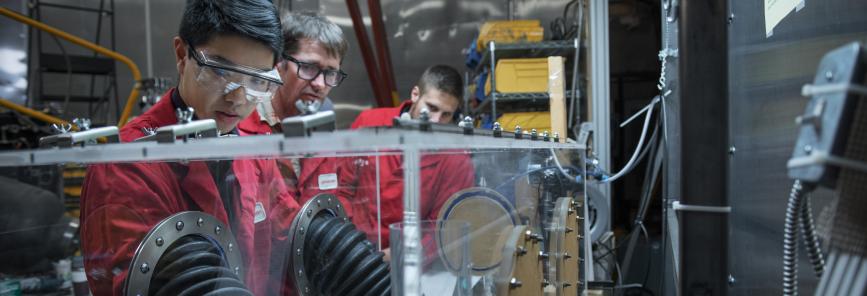
Engineering Physics (BASc) is one of the most competitive programs at UBC, immersing students in a comprehensive curriculum that focuses on providing a robust education in mathematics, physics and applied technologies. It’s credited as being a fairly intensive program that aims to equip students with progressive technical innovation skills, problem solving skills and project work skills to be highly effective across several engineering disciplines.
Engineering Physics students’ learnings are further enhanced through a real-world learning approach to education, which includes a series of hands-on courses, autonomous robotics competitions, advanced physics experiments, as well as research and engineering project courses.
All of above enables these students to be effective Co-op employees in terms of both contributing their academics to existing projects and workflows, as well as being able to play a critical role a critical role in the process of taking new ideas from concept to practical application. Hiring managers who have hired Engineering Physics Co-ops have overwhelmingly agreed that Engineering Physics Co-ops do make excellent Co-op employees, as 94% have continued to rate these students as Excellent or Above Average!
Interested in bringing an Engineering Physics Co-op student on to your team for 4 or 8 months? Common roles that these students are hired for include mechanical and electrical design, mechatronics and electronics engineering, robotics and automation, computer and software engineering, machine learning and AI and research in physics and quantum mechanics.
Please review our tips for creating an effective job description!
Areas of Academic Focus
Electrical
In addition to a core electrical engineering curriculum (linear circuits, digital systems and microcontrollers, and electronics laboratory techniques) students take two physics courses in electromagnetism. These courses provide Engineering Physics students with a much deeper understanding of the fundamental principles underlying electrical engineering, and better prepare them for tackling complex or novel problems. Additionally, their deeper training in mathematics (linear algebra, multivariable and vector calculus, ordinary and partial differential equations) better equips them to rigorously deal with complex problems.
Mechanical
In addition to core mechanical engineering courses like statics and dynamics, mechanics of materials, fluid mechanics, and engineering materials, Engineering Physics students take courses in classical mechanics and thermal physics that will give them a richer and deeper understanding of multifaceted mechanical problems. Additionally, their deeper training in mathematics (linear algebra, multivariable and vector calculus, ordinary and partial differential equations) better equips them to rigorously deal with complex problems.
Mechatronics
In addition to core courses in electrical and mechanical engineering, Engineering Physics students complete additional physics and mathematics courses in classical mechanics, multivariable and vector calculus, linear algebra, optics, and thermodynamics. This deeper training in physics and mathematics provides Engineering Physics students with a more rigorous understanding of and approach to solving multifaceted problems in mechatronics, whether it be designing a highly dynamic automated system or choosing a sophisticated optical- or vision-based sensor. Students also take two courses in control theory and have deeper training in linear algebra and complex analysis to tackle complicated control problems.
Physics
While most engineering students study physics up to the end of first year only, Engineering Physics students take a broad range of fundamental physics courses throughout all five years of their degree: heat and thermodynamics, classical mechanics, modern physics (relativity and quantum mechanics), electromagnetism (electrostatics and electrodynamics, Maxwell's Equations), quantum mechanics, classical mechanics, statistical mechanics, and optics. In addition to these physics courses, students take a correspondingly full slate of mathematics (multivariable and vector calculus, ODEs, PDEs, linear algebra, complex analysis, probability, applied PDEs, Green's functions and variational methods). These courses provide students with deep and broad exposure to the physical phenomena underpinning all engineering disciplines, allowing them to tackle any problem from a fundamentals-first perspective while appreciating the interconnected nature of complex engineering problems.
Software
In addition to core software concepts like specifications, testing, source control, fundamental algorithms (recursion, tree traversals, sorting), abstraction, encapsulation, inheritance, concurrency (threads and mutexes), exceptions and error-handling through their coursework Engineering Physics students also have experience developing solutions using a variety of computer vision techniques from SIFT to deep learning models, simple user interfaces, controlling robots in simulation and real, and also creating custom compute solutions on FPGA hardware. These skills are reinforced by a wide range of applied numerical courses: applied linear algebra, applied partial differential equations, numerical methods for differential equations, probability and statistics (in multiple instantiations - from standard mathematics to quantum physics and statistical mechanics), computational physics, signal processing and control theory. These additional courses make Engineering Physics students well qualified for contributing to fields that require modelling and simulation, robotics, optimization, machine learning research and also firmware development.
ENPH Co-op Work Term Schedule
| Employment | Availability | Academic Year |
|---|---|---|
| January Start | 4 months | 2nd year |
| May Start | 4 and 8 Months | 3rd year |
| May Start | 4 months | 4th year |
| September Start | 4 months | *3rd year (very limited number of students available) |
- Mechanical and electrical design
- Robotics and automation
- Automotive design and manufacturing
- Analog, digital and integrated circuits
- Software development and database development
- Product development and testing, data collection and analysis
- Prototyping and design
- Electronic assembly, testing and debugging
- Conducting laboratory experiments and instrument design
- C, Python, AutoCad, C++, Java, SQL
- Oscilloscopes, Multimeters, and other electrical engineering tools
- Solid understanding of engineering principles, standards and best practices